When Amy Merricks was appointed as the new Birmingham City Women’s manager earlier this year, it seemed as though it was a match made in heaven.
Having developed under Hope Powell at Brighton, Merricks was identified as a young and progressive coach who could help Birmingham return to the Women’s Super League.
Things appear to be coming to fruition for the Blues this season, as they currently sit atop the Women’s Championship on the back of some offensive-minded and tactically expansive play.
She is undoubtedly paving the way for female coaches in the world of football.
Her relentless nature has allowed Birmingham to become an impressive women’s football outfit again.
The following scout report and tactical analysis will dive into some key features of Amy Merricks' managerial style, focusing on the impressive tactical tweaks that have allowed the Blues to consistently threaten their opposition.
We will also identify how their pressing structure has bolstered their presence in the final third but can also lead to some negative consequences at the wrong end of the pitch.
Initial Build-Up Phase
Throughout this season at Birmingham City Women, Merricks has encouraged a deep build-up phase centred around maintaining ball possession while remaining progressive and damaging to the opposition’s defensive structure.
Birmingham have usually lined up in either the 4-2-3-1 or 4-1-4-1, meaning that Merricks' side will often interchange between a single or double pivot as clear passing options for central progression.
However, the height of their full-backs and the confidence that the central defenders have when moving with the ball indicate that Birmingham have been much more effective when building up along the flanks.
The following image provides an informative snapshot of Merricks’ usual in-possession structure as her side plays out from their box against Newcastle.

With Newcastle marking the Birmingham pivot man-to-man, Merricks’ side can use the space in the channels to progress the ball quickly, thanks to the movement of their roaming playmaker and the right winger, who has adopted a more centralised position.
This was also an effective strategy against Bristol City, with one winger stretching the width of the defensive line whilst the other could move infield to play closer to Birmingham’s other attacking outlets.
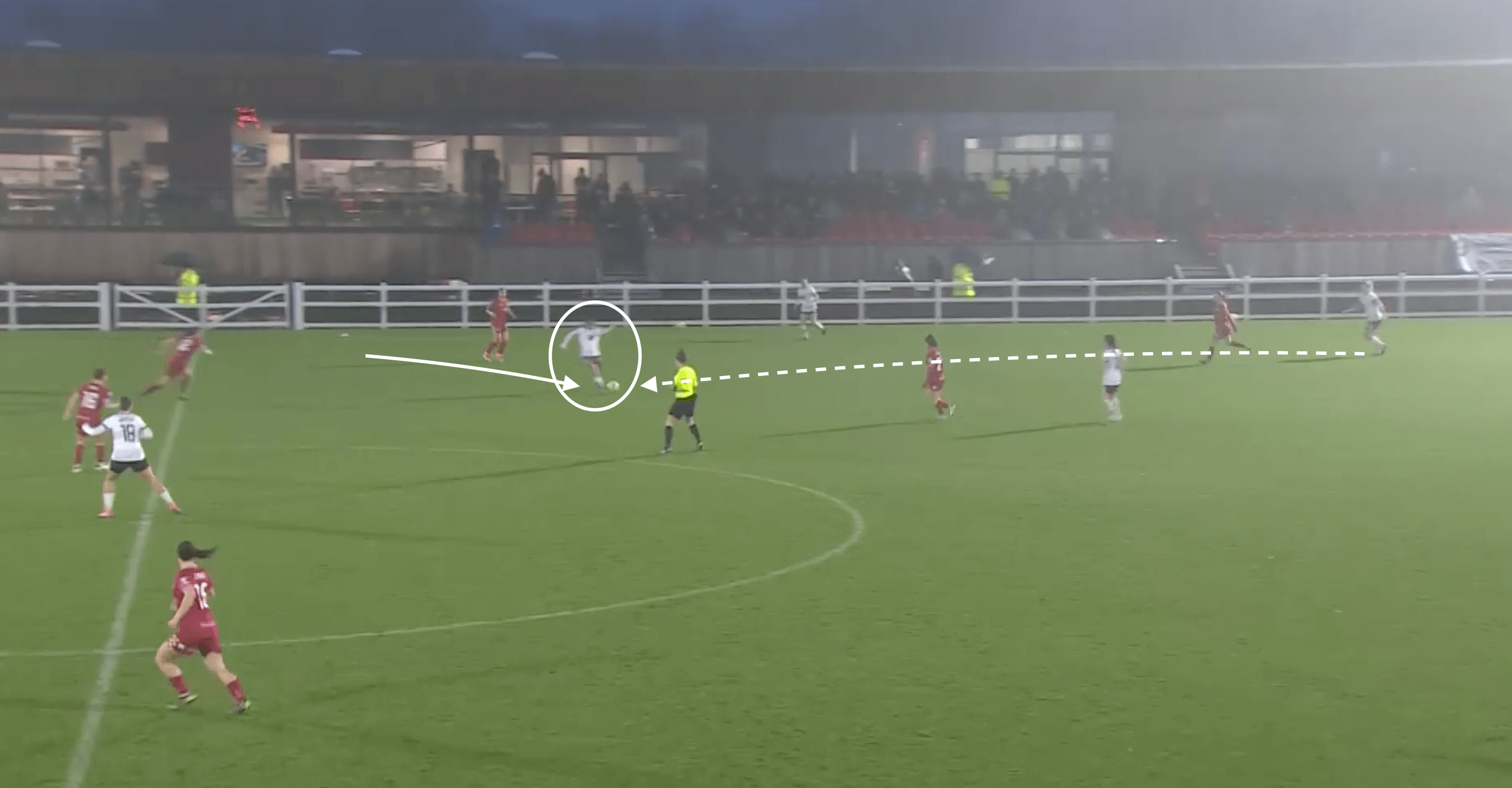
We also see how this strategy can be implemented to draw defensive attention away from the flanks.
Birmingham’s left winger looks to attract the Newcastle right-back, while runners look to exploit the space left behind.

Birmingham is atop the Barclays Women’s Championship, and they certainly possess the attacking confidence to commit players forward in a 2-3-5 shape.
Their left back is an integral part of their offensive shape.
While it would appear risky to commit so many bodies forward, Birmingham’s excellent defensive record could be attributed to their midfield rotations and intelligence in picking up space in the middle to defensive thirds.
In their recent match against Charlton, Neve Herron's movement indicates that the central defender was attempting to launch a diagonal pass towards the right flank for Choe Yu-ri to meet in stride.
To plug this gap, which could have been exposed in transition, Christie Murray rotates into the left centre-back role, while Lee Geum-min drops in to support Cho Hyun in the double pivot.
This sufficiently bolsters Birmingham’s 3-2 rest defence should Charlton regain possession high.
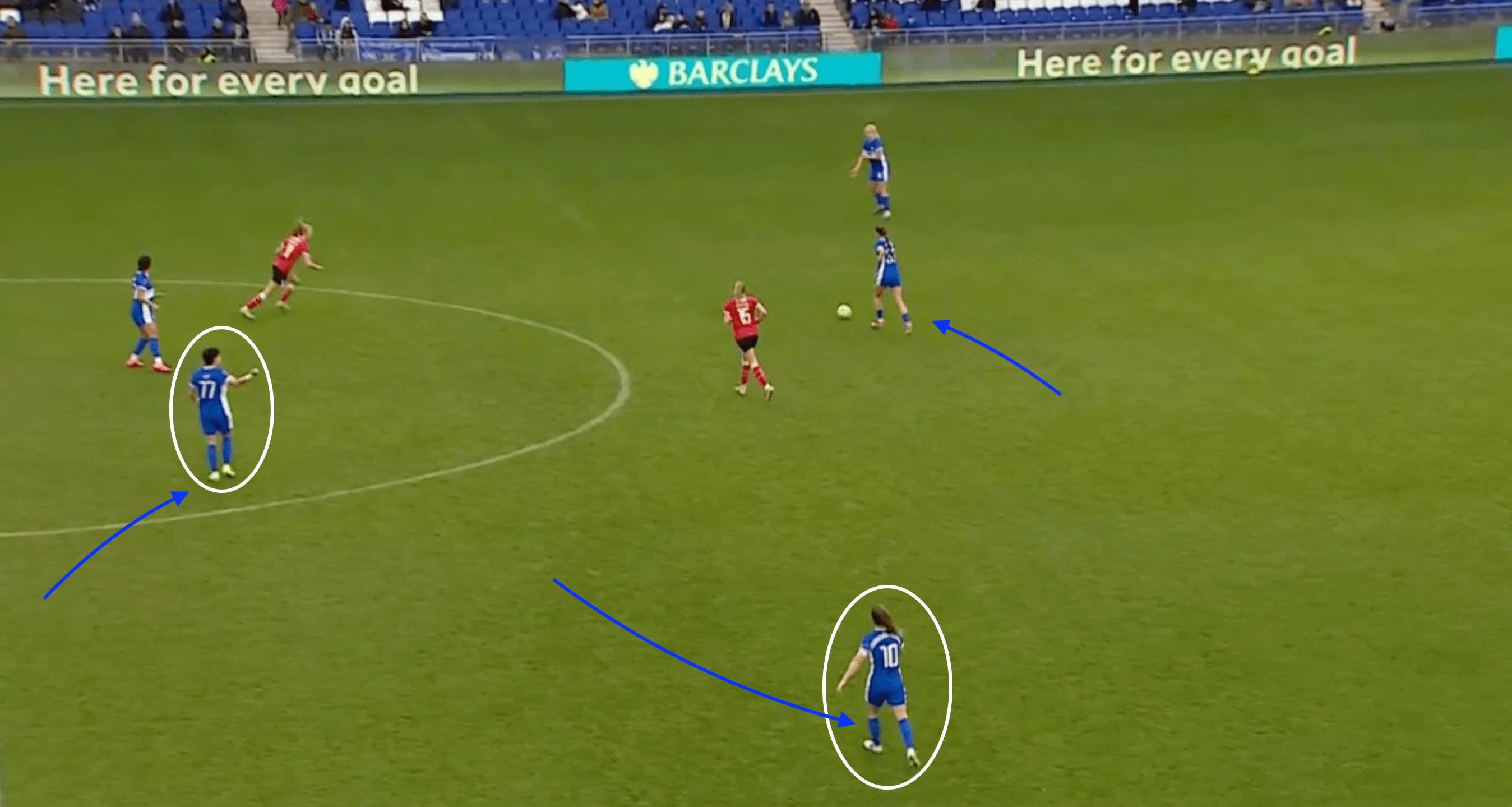
Amy Merricks Attacking Style
After gaining initial insight into the Birmingham build-up play under Amy Merricks, it is easy to see why she places a huge responsibility on the split central defenders to progress the ball up the pitch.
The full-backs' remaining wide frees up the two central defenders to progress the ball through the channels.
They can link play by directly passing to the Birmingham striker's feet or even driving at speed through the half-space.
These attacking sequences are ultimately a result of Birmingham’s impressive technical qualities, which span the entire squad.
These qualities allow them to move the ball quickly using overloads out wide and impressive combinations to confuse opposing defences.
Under Merricks this season, Birmingham have maintained a league-leading 58.1% average ball possession whilst also ranking second in the Women’s Championship for progressive passes per 90 (76.13).
One focal point of their attack is their leading striker, who they often use as a decoy to release others behind.
Simone Magill has featured heavily for Merricks this season, and against Leicester, we saw how the aforementioned passes through the channel could result in dangerous attacking opportunities for Birmingham.
Having affected Leicester's defensive coordination by drawing in a tight marker, Magill can quickly release the ball into the path of advanced midfielder Cho So-hyun, eventually threading the ball through for right winger Ava Baker to enter the penalty area.

Similar sequences were on display against the London City Lionesses, but this time, we saw Ivana Fuso becoming the beneficiary from that inverted winger position.
Importantly for Merricks, such movements create much more of a favourable attacking matchup for Birmingham, with the mobile and technical Fuso now able to threaten a displaced central defender with no defensive support in behind.
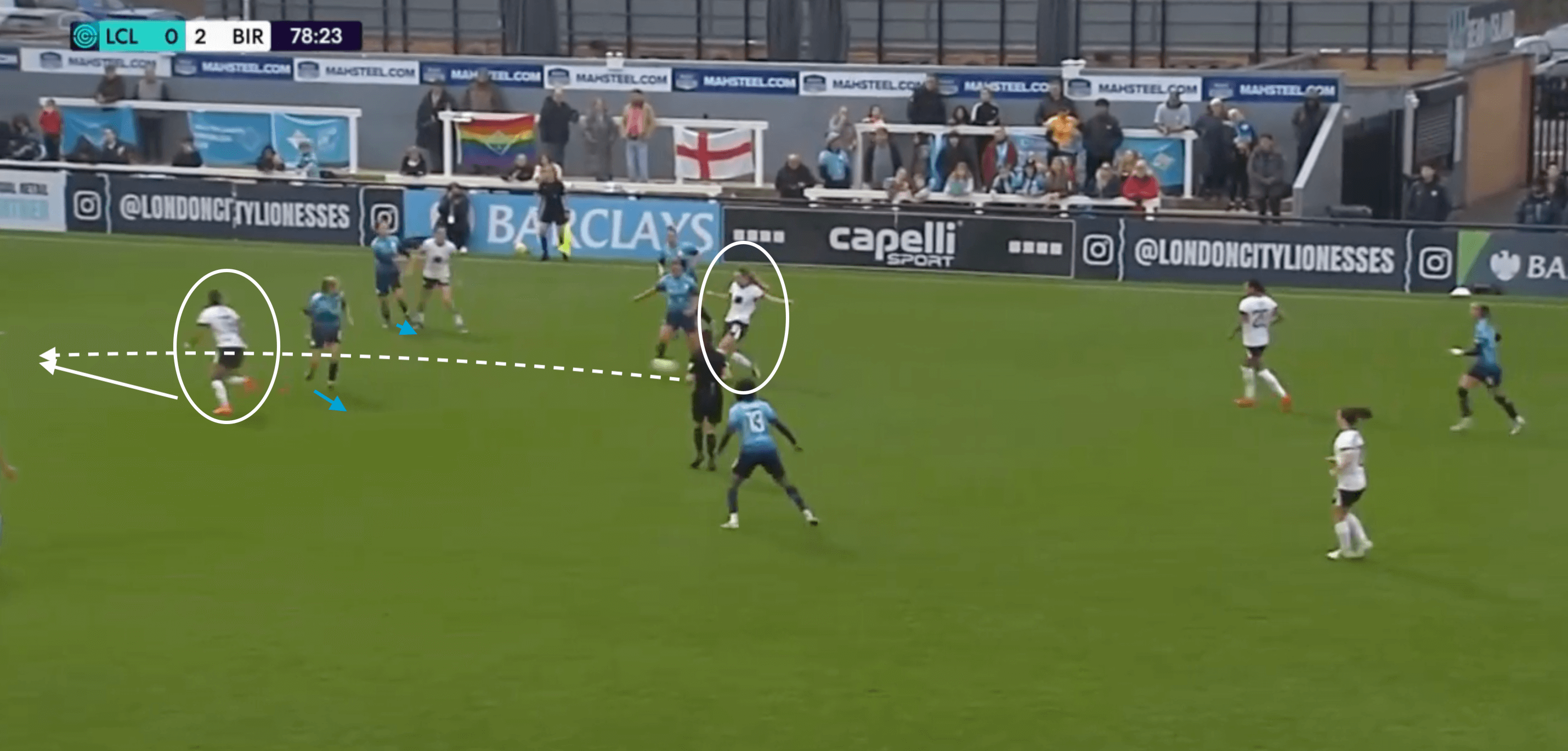
An integral element of these opportunities where the Birmingham wingers are isolated has been the ability for their full-backs to occupy space within the attacking third.
Although their indirect influence has been important for Birmingham’s attacking success, their direct contributions can also be equally effective.
The first of which can be highlighted in Birmingham’s visit to Southampton, where Tegan McGowan was able to release a through ball into the path of Rebecca McKenna after some impressive hold-up play through the centre.
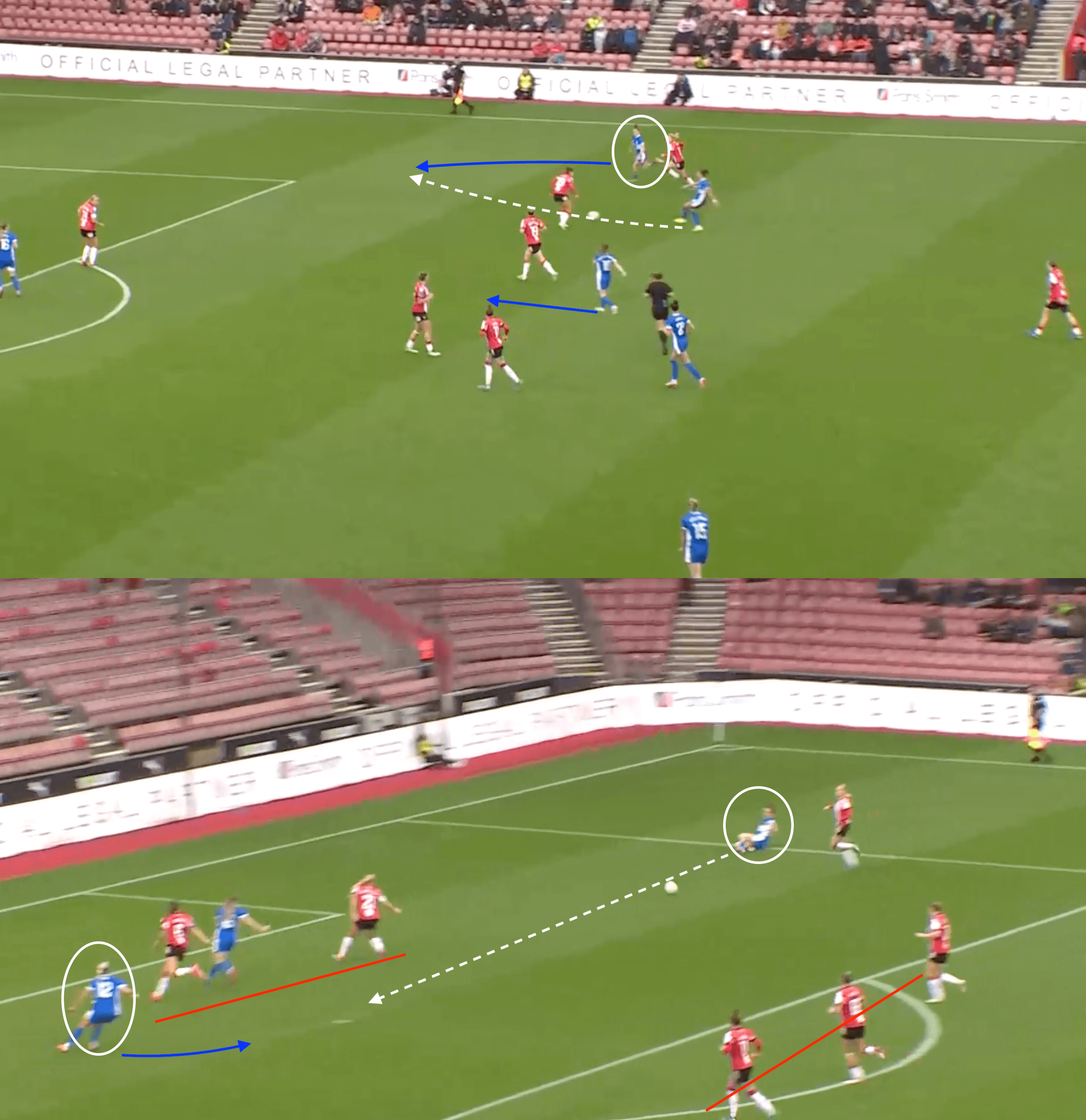
McKenna can stride into the final third unopposed before cutting back an excellent cross to damage Southampton between the lines.
This is perfect for Lily Agg, who can act as a roaming playmaker just behind the forward line.
On the opposite flank, we see how Rebecca Holloway's underlapping movement can devastate Sunderland's defensive structure.
Not only does her initial positioning through the half-space open up a direct passing lane to Ivana Fuso on the flank, but her eventual run into the final third forces the defensive line to shift aggressively across, leaving more space in the penalty area for potential cut-backs or direct passes to the striker.

This only further emphasises Birmingham’s impressive box presence this season, with Merricks’ side recording 21.65 penalty area touches per 90.
Another interesting feature that has contributed to this is the movement of Birmingham’s advanced central midfielders when operating in variations of 4-1-4-1 and 4-3-3.
The late runs into the box have allowed Birmingham to rack up an impressive eight headed goals so far this season, blowing the league average of 1.64 out of the water.
This is supported by their 27 headed shots, which are almost double the league average of 13.82.
The following example highlights the damaging run from Lee Geum-min, which caught the Portsmouth defence on their heels.
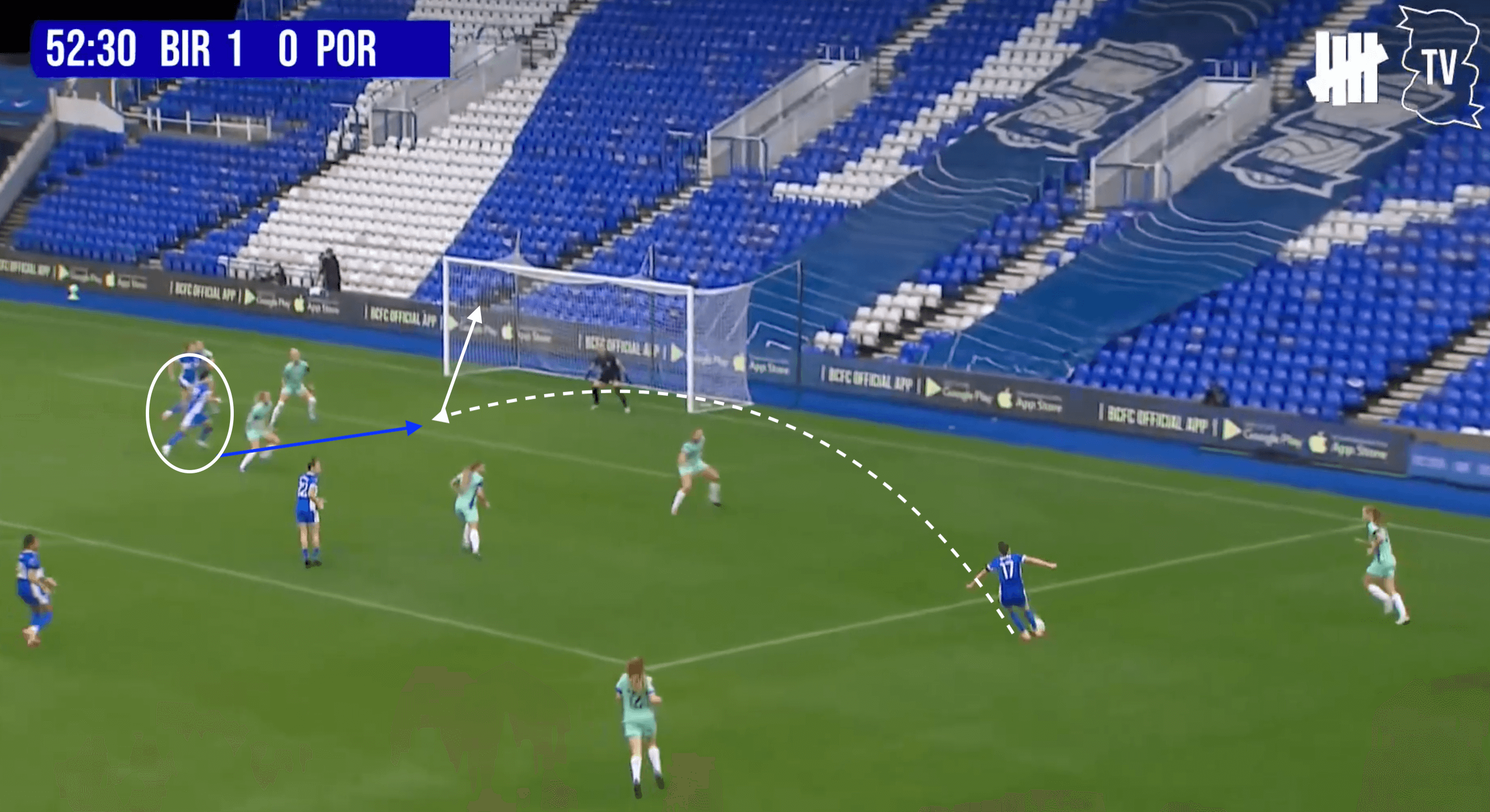
Pressing Effectiveness
Another key element contributing to Birmingham’s ball dominance is its ability to press the opposition and create high turnovers, which can be dangerous in transition against an unstructured defence.
When Merricks’ side are out of possession, they currently rank as the lowest team in the Women’s Championship for defensive duels per 90 (67.35), but the critical fact would have to be that they maintain a 69.5% success rate should they need to engage in one.
It is more important to highlight their pressing effectiveness, which is often understood using metrics such as challenge intensity and passes per defensive action (PPDA).
Birmingham currently boasts a challenge intensity of 6.9 and a PPDA score of 6.99, key factors of a successful high-pressing team that is proactive in its defensive actions.
This season, Birmingham have usually pressed in more of a 4-1-4-1 shape, with a lone striker aiming to apply pressure towards the two central defenders.
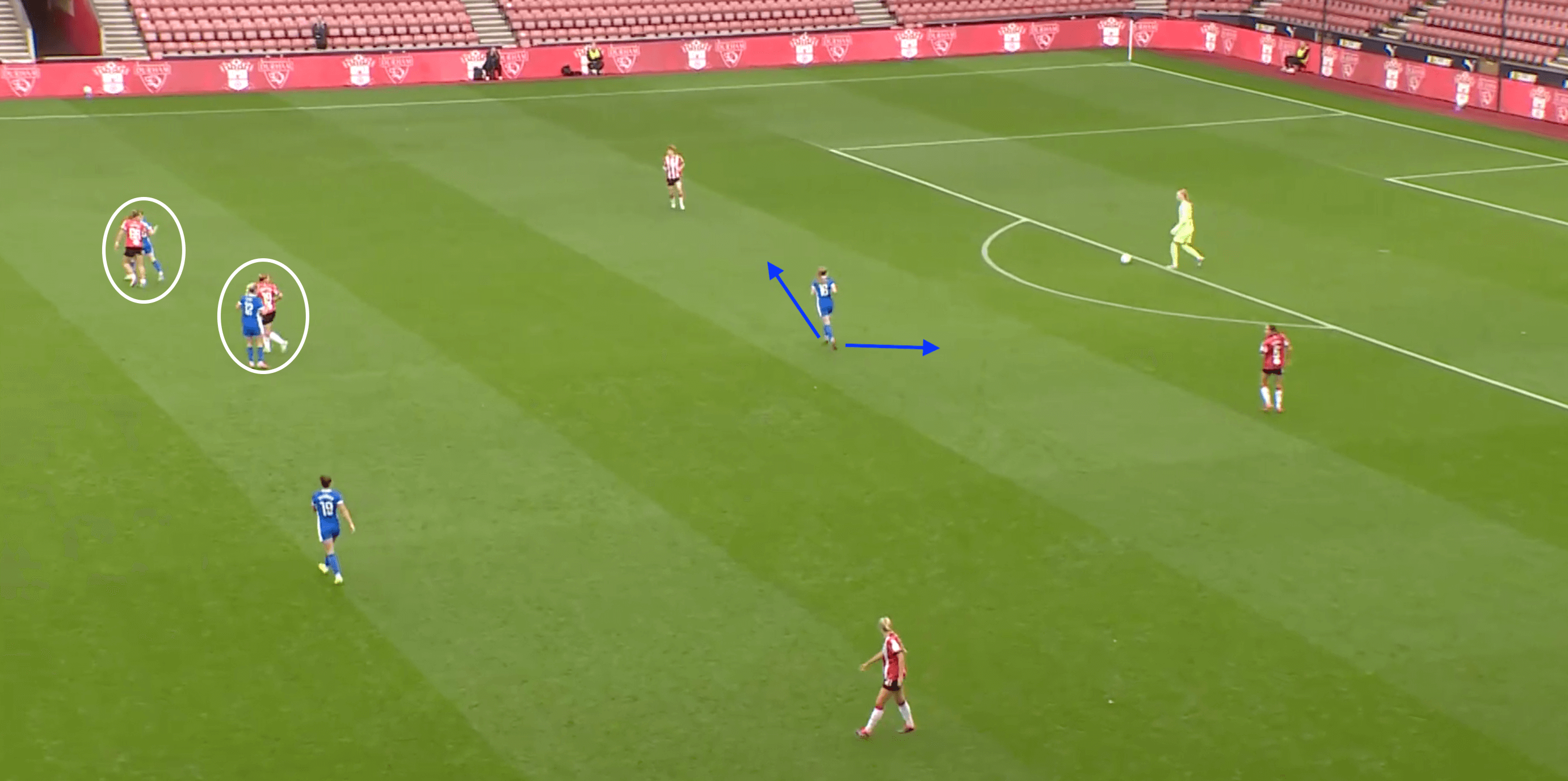
They can then apply man-to-man pressure on the opposing double-pivot with another holding midfielder deployed to either screen the defensive line or tightly mark an opposing advanced playmaker.
Whilst this would also allow the opposition to look to advance through the channels in a similar manner to Merricks’ team, we see against Southampton how the mobility of the Birmingham midfield can help to intercept play and attack in transition.

Even when facing opposition from the WSL, Birmingham's press was engaged and persistent, resulting in a goal-ending turnover.
When facing Leicester, the commitment of Birmingham’s midfielders to advance and close down space quickly saw an inaccurate pass land at the feet of Ava Baker, who made no mistake with her drilled strike from distance.

Another thing that makes Birmingham a top side under Amy Merricks would be their ability to recognise when they negatively impact opposition build-up and how they can amplify this with a tweak to their initial press.
In their match against Bristol City, Birmingham consistently forced their opposition into wayward passes, stifling their ability to progress up the pitch.
This facilitated a switch to a two-headed pressing effort from the front line.
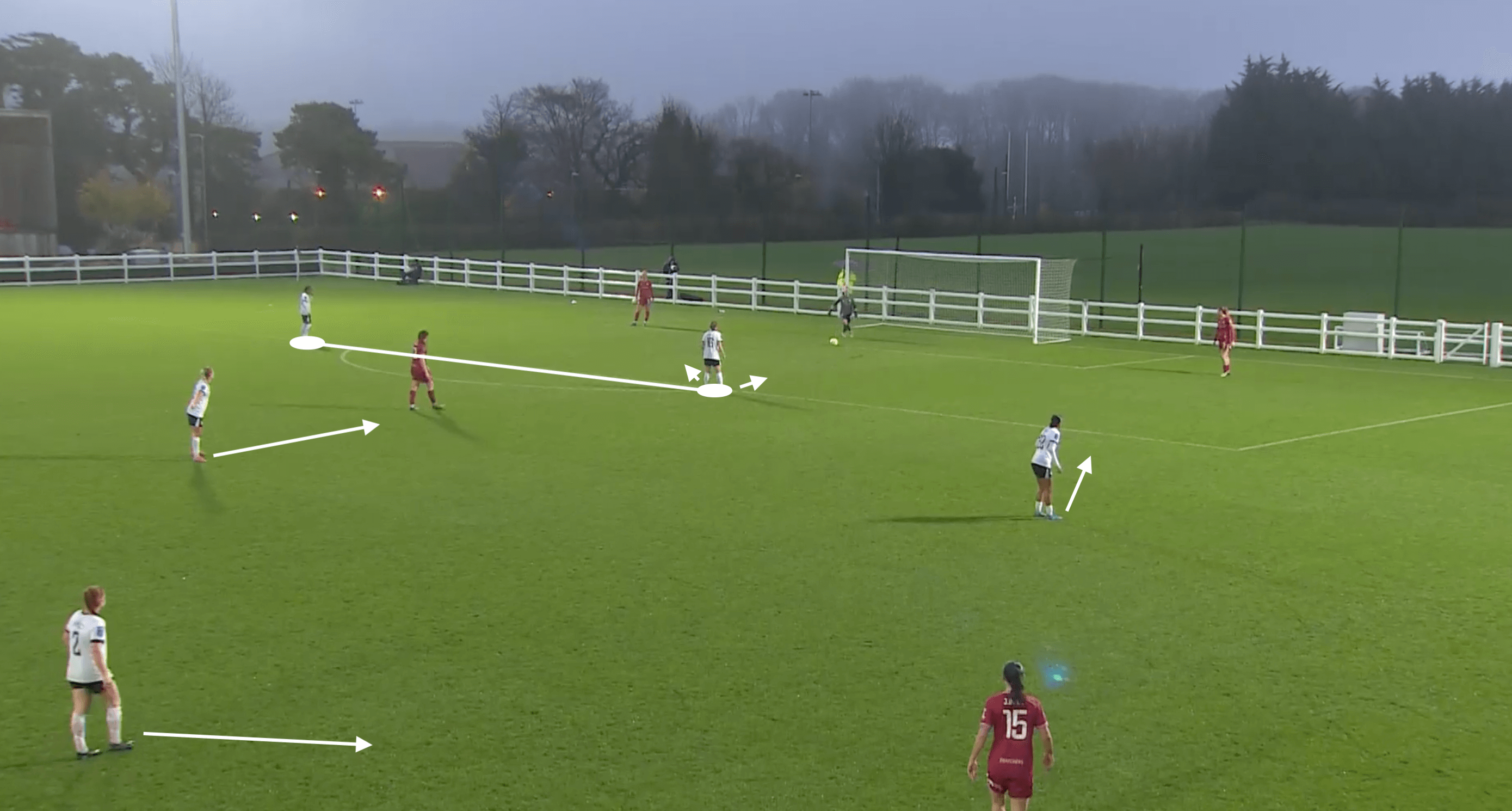
Birmingham could allow one of their wingers to move inside from the left flank after assessing the long passing ability of the Bristol City goalkeeper, creating an opportunity for the whole team to advance slightly and adopt a higher point of initial press.
Defensive Capabilities
Even though Birmingham’s attacking efforts have been an impressive feature of their game, Amy Merricks is quietly guiding the Blues to an excellent defensive record in the Women’s Championship.
Despite conceding an overall expected goal against figure of 12.09 xGA this season, this has only amounted to the concession of 5 actual goals after ten matches.
Whilst this stands out as a significant overachievement when looking at the bigger picture, Birmingham have been comforted by the aforementioned pressing qualities and rest defence they have displayed to counteract their offensive nature.
Given this, one of the only fundamental weaknesses of Birmingham’s game under Merricks is that the chances they concede are significant in nature and quality.
Birmingham currently ranks third in the Women’s Championship for expected goal per shot against, with 0.146.
This indicates that the opposition usually has a greater chance of scoring whichever attacking opportunities they manage to create.
Having analysed the goals that Birmingham have conceded this season, their most evident defensive weakness revolves around a lack of support from the wide midfielders tracking back.
It allows opposing wingers to create advantageous 1v1 scenarios against the Birmingham full-backs, which we know can often be advanced and caught out of position in transition.
Without the Birmingham wide players tracking back to support defensively, we see how easily the Birmingham defenders can be displaced to allow passes to be cut across the face of the penalty area.
This was evident against Leicester when Birmingham’s defensive line was severely stretched and could not stop the overwhelming double-up that the hosts had on the right flank.

It was also noted how a desire to play short possession-based football could backfire when ideas around build-up play were misaligned.
In their match against Sheffield United, one of the central defenders dropped off the defensive line to offer a short passing outlet to the goalkeeper.
Instead, the keeper opted to go long into a zone where the Birmingham midfield was unstructured.
The sequence allowed Sheffield United to easily cut out the long pass and quickly play the ball into the feet of the unmarked forward, rapidly creating a 4v3 attacking scenario that allowed them to score.
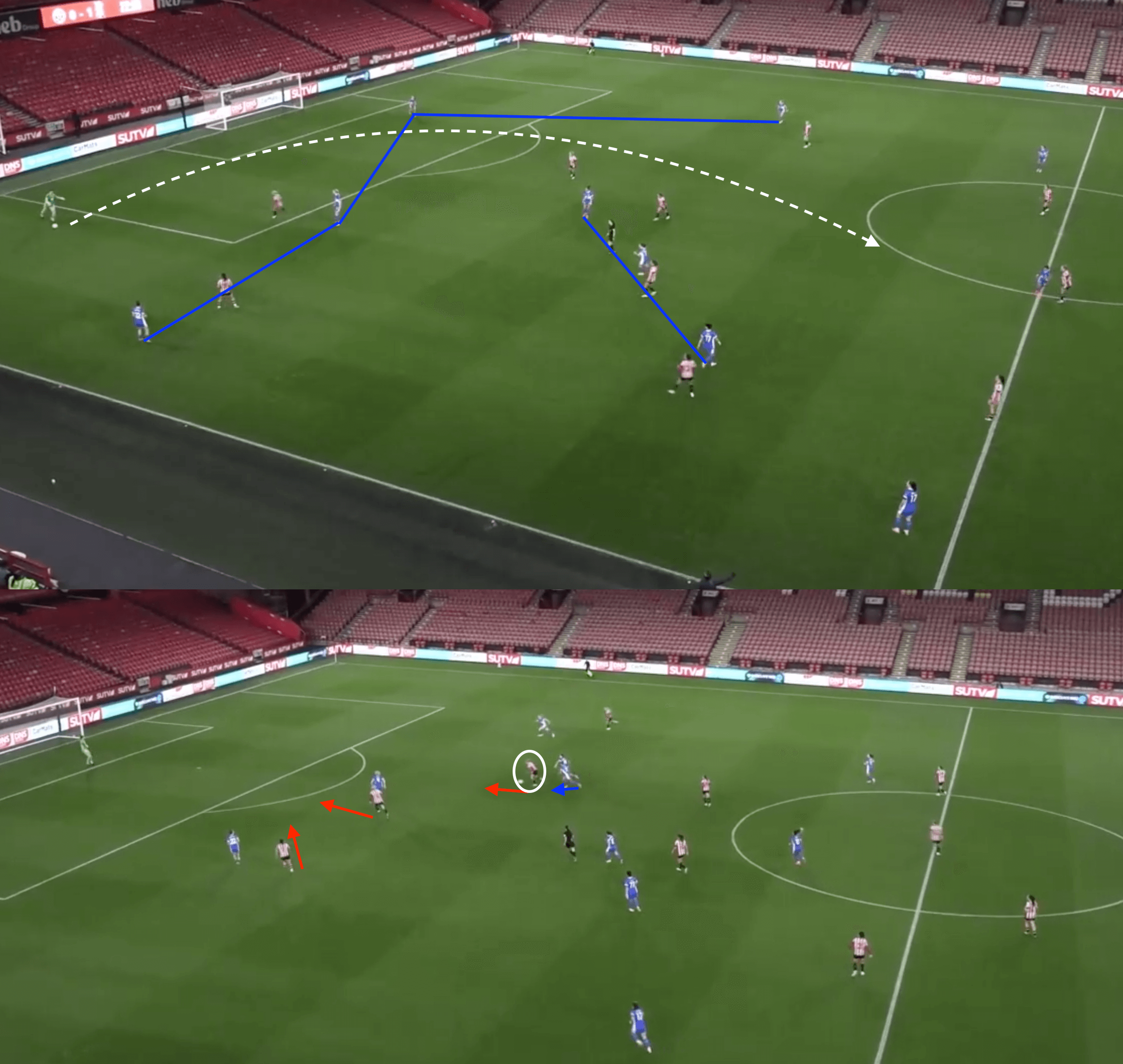
Conclusion
Even though things may not be perfect for Birmingham and Amy Merricks, they are developing a serious charge to the title.
Having maintained an impressive record during their league matches, their cup encounters have also highlighted how they might fare against stronger opposition upon a potential return to the WSL.
Despite premature talk of promotion, Amy Merricks has asserted herself as a really intriguing up-and-coming manager, with the tactical nous to unlock the best out of her Birmingham City side.





Comments